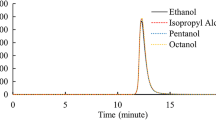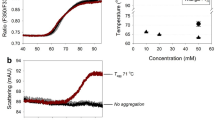Abstract
Three denaturing techniques have been evaluated for their ability to induce irreversible aggregation and precipitation of recombinant porcine growth hormone (pGH). The denaturing stimuli included thermal denaturation, interfacial denaturation through the introduction of a high air/water interface by vortex agitation, and a guanidine (Gdn) HC1 technique which involved rapid dilution of a partially unfolded state of pGH to nondenaturing conditions. Soluble and insoluble pGH fractions were evaluated for the presence of covalently modified species and soluble aggregates by size exclusion chromatography (SEC), sodium dodecyl sulfate–polyacrylamide gel electrophoresis (SDS-PAGE), and isoelectric focusing (IEF). In each of the three denaturation methods, precipitation was found to be irreversible, as the precipitated pellet could not be solubilized upon resuspending in buffer. The soluble pGH fractions consisted of only monomeric material and the insoluble protein pellet could be completely solubilized with Gdn HC1 or SDS. There was no evidence of detectable covalent modifications in the precipitated protein pellet following any of the three denaturation techniques. Three excipients, Tween 20, hydroxypropyl-β-cyclodextrin (HPCD), and sorbitol were evaluated for their stabilizing ability using each of the three denaturation methods and the degree of stabilization was found to be dependent upon the denaturing stimulus incorporated. Tween 20 was found to be highly effective in preventing pGH precipitation using the interfacial and Gdn techniques and was moderately effective using the thermal denaturation method. Inclusion of HPCD in the sample buffer significantly reduced precipitation using the thermal and interfacial methods but was ineffective in the Gdn technique. In contrast, sorbitol was ineffective in the interfacial technique and only moderately effective at high concentrations in reducing Gdn- and thermally-induced precipitation. These studies demonstrate the need to consider the nature of the denaturing stimulus when evaluating the potential protein-stabilizing properties of different pharmaceutical excipients.
Similar content being viewed by others
REFERENCES
R. Jaenicke. Folding and association of proteins. Prog. Biophys. Mol. Biol. 49:117–237 (1987).
P. L. Privalov. Stability of proteins. Small globular proteins. Adv. Protein Chem. 33:167–241 (1979).
P. L. Privalov and S. J. Gill. Stability of protein structure and hydrophobic interaction. Adv. Protein Chem. 39:191–234 (1988).
K. A. Dill. Dominant forces in protein folding. Biochemistry 29:7133–7155 (1990).
G. Zettlmeissl, R. Rudolph, and R. Jaenicke. Reconstitution of lactic dehydrogenase. Noncovalent aggregation vs. reactivation. 1. Physical properties and kinetics of aggregation. Biochemistry 18:5567–5571 (1979).
M. E. Goldberg, R. Rudolph, and R. Jaenicke. A kinetic study of the competition between renaturation and aggregation during the refolding of denatured-reduced egg white lysozyme. Biochemistry 30:2790–2797 (1991).
Y.-C. J. Wang and M. A. Hanson. Parenteral formulations of proteins and peptides: Stability and stabilizers. J. Parent. Sci. Technol. 42:S4–S24 (1988).
M. C. Manning, K. Patel, and R. T. Borchardt. Stability of protein pharmaceuticals. Pharm. Res. 6:903–918 (1989).
S. N. Timasheff and T. Arakawa. Stabilization of protein structure by solvents. In T. E. Creighton (ed.), Protein Structure: A Practical Approach, Oxford University Press, New York, 1990, pp. 331–345.
T. Arakawa, Y. Kita, and J. F. Carpenter. Protein-solvent interactions in pharmaceutical formulations. Pharm. Res. 8:285–291 (1991).
T. A. Bewley. A novel procedure for determining protein concentrations from absorption spectra of enzyme digests. Anal. Biochem. 123:55–65 (1982).
D. N. Brems. Solubility of different folding conformers of bovine growth hormone. Biochemistry 27:4541–4546 (1988).
S. S. Abdel-Meguid, H.-S. Shieh, W. W. Smith, H. E. Dayringer, B. N. Violand, and L. A. Bentle. Three-dimensional structure of a genetically engineered variant of porcine growth hormone. Proc. Natl. Acad. Sci. USA 84:6434–6437 (1987).
S. Bastiras and J. C. Wallace. Equilibrium denaturation of recombinant porcine growth hormone. Biochemistry 31:9304–9309 (1992).
D. N. Brems, S. M. Plaisted, H. A. Havel, E. W. Kauffman, J. D. Stodola, L. C. Eaton, and R. D. White. Equilibrium denaturation of pituitary-and recombinant-derived bovine growth hormone. Biochemistry 24:7662–7668 (1985).
W. Pfeil. The problem of the stability of globular proteins. Mol. Cell. Biochem. 40:3–28 (1981).
C. N. Pace, B. A. Shirley, and J. A. Thomson. Measuring the conformational stability of a protein. In T. E. Creighton (ed.), Protein Structure: A Practical Approach, Oxford University Press, New York, 1990, pp. 311–330.
T. J. Ahern and A. M. Klibanov. The mechanism of irreversible enzyme inactivation at 100°C. Science 228:1280–1284 (1985).
S. E. Zale and A. M. Klibanov. Why does ribonuclease irreversibly inactivate at high temperatures? Biochemistry 25:5432–5444 (1986).
D. B. Volkin and A. M. Klibanov. Thermal destruction processes in proteins involving cystine residues. J. Biol. Chem. 262:2945–2950 (1987).
M. J. Hageman, J. M. Bauer, P. L. Possert, and R. T. Darrington. Preformulation studies oriented toward sustained delivery of recombinant somatotropins. J. Agr. Food Chem. 40:348–355 (1992).
F. MacRitchie. Spread monolayers of proteins. Adv. Colloid Interface Sci. 25:341–385 (1986).
W. Norde. Adsorption of proteins from solution at the solid-liquid interface. Adv. Colloid Interface Sci. 25:267–340 (1986).
J. D. Andrade. Principles of protein adsorption. In J. D. Andrade (ed.), Surface and Interfacial Aspects of Biomedical Polymers, Vol. 2. Protein Adsorption, Plenum Press, New York, 1985, pp. 1–80.
A. F. Henson, J. R. Mitchell, and P. R. Mussellwhite. The surface coagulation of proteins during shaking. J. Colloid Interface Sci. 32:162–165 (1970).
M. J. Pikal, K. M. Dellerman, M. L. Roy, and R. M. Riggin. The effects of formulation variables on the stability of freeze-dried human growth hormone. Pharm. Res. 8:427–436 (1991).
K. Kuwajima. The molten globule state as a clue for understanding the folding and cooperativity of globular-protein structure. Proteins Struct. Funct. Genet. 6:87–103 (1989).
P. S. Kim and R. L. Baldwin. Intermediates in the folding reactions of small proteins. Annu. Rev. Biochem. 59:631–660 (1990).
W. D. Lougheed, A. M. Albisser, H. M. Martindale, J. C. Chow, and J. R. Clement. Physical stability of insulin formulations. Diabetes 32:424–432 (1983).
M. E. Brewster, J. W. Simpkins, M. S. Hora, W. C. Stern, and N. Bodor. The potential use of cyclodextrins in parenteral formulations. J. Parent. Sci. Technol. 43:231–240 (1989).
M. E. Brewster, M. S. Hora, J. W. Simpkins, and N. Bodor. Use of 2-hydroxypropyl-β-cylcodextrin as a solubilizing and stabilizing excipient for protein drugs. Pharm. Res. 8:792–795 (1991).
J. F. Back, D. Oakenfull, and M. B. Smith. Increased thermal stability of proteins in the presence of sugars and polyols. Biochemistry 18:5191–5196 (1979).
K. Gekko and T. Morikawa. Thermodynamics of polyol-induced thermal stabilization of chymotrypsinogen. J. Biochem. 90:51–60 (1981).
K. Gekko. Calorimetric study of thermal denaturation of lysozyme in polyol-water mixtures. J. Biochem. 91:1197–1204 (1982).
L. S. Wan and P. F. S. Lee. CMC of polysorbates. J. Pharm. Sci. 63:136–137 (1974).
S. Tandon and P. M. Thorwitz. Detergent-assisted refolding of guanidinium chloride-denatured rhodanese. J. Biol. Chem. 262:4486–4491 (1987).
M. Hagenlocher and R. Pearlman. Use of a substituted cyclodextrin for stabilization of solutions of recombinant human growth hormone. Pharm. Res. 6:S30 (1989).
Author information
Authors and Affiliations
Rights and permissions
About this article
Cite this article
Charman, S.A., Mason, K.L. & Charman, W.N. Techniques for Assessing the Effects of Pharmaceutical Excipients on the Aggregation of Porcine Growth Hormone. Pharm Res 10, 954–962 (1993). https://doi.org/10.1023/A:1018994102218
Issue Date:
DOI: https://doi.org/10.1023/A:1018994102218




